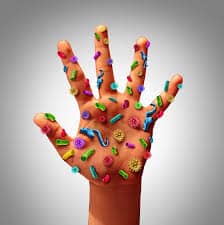You finish cleaning the restrooms in an office building and head to the break room. While it may seem more efficient to transport the cleaning tools you just used from the restroom into the kitchen, taking the extra time to set up new tools is necessary to prevent cross-contamination. Cross-contamination is the act of transporting germs and bacteria from one place in a facility to another and can be done unintentionally during cleaning.
For instance, a custodian could wipe down a toilet that was exposed to norovirus and then use the same cleaning tool to wipe down the sinks, spreading the virus. Or a custodian could clean a kitchen sink contaminated with raw chicken debris containing the salmonella virus and then use the same cloth to wipe the kitchen counter. While these may seem like simple mistakes, they could lead to the spread of norovirus or salmonella among a company’s employees who come in contact with those surfaces throughout the day. A wide range of businesses, from offices and restaurants to hospitals and schools, depend on custodians to maintain a healthy facility for employees and customers. By following three steps, professional cleaners can ensure a building is not only clean, but contaminant-free.
COLOR CODE AND CATEGORIZE:
Devise a system to help staff remember to switch their cleaning cloths and tools once they complete a particular task. Microfiber cloths and mop heads come in a minimum of four colors: red, yellow, blue and green.
Red: sanitary appliances, restroom floors, toilets and urinals.
Yellow: restroom surfaces, including sinks, towel dispensers, hand dryers, soap dispensers, door handles and walls.
Green: general food and bar clean-up in non-preparatory food areas, such as lunch rooms.
Blue: areas at low risk of contamination, such as hallways, offices and classrooms.
Correct cleaning tool storage is crucial to maintaining the separation accomplished by color coding. Ensure the janitor’s closet is well organized with cleaning supplies for each room stored in a separate space. In addition to a variety of colors, microfiber cloths and mops offer a unique particle-trapping property. Microfibers have a positive charge that attracts dust, which has a negative charge. After the microfibers attract the dust they hold these particles tightly so they are not redistributed around a room during cleaning.
Cross-contamination often begins at high-touch areas, such as door knobs, counters and railings. Floors are another source for germs and bacteria, with gravity pulling soil and germs to them. A methodological cleaning process works best to avoid missing any areas of a room. Custodians should clean from top to bottom so dust and dirt that isn’t captured in the cleaning tool falls to the floor and is picked up during the final steps. Always wipe down surfaces first, disinfect second and tackle the floor last.
EcoCare is a Eco-friendly commercial cleaning company in Austin and San Antonio, TX that practice these rules to prevent cross-contamination. Call us today for a free quote.
Credit: Cleaning & Maintenance Management Magazine by Kathleen Misovic

